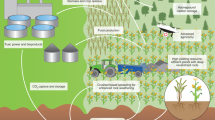Abstract
To meet the challenge of food security in the twenty-first century, global agricultural output must be increased. This will put pressure on already strained surface and groundwater resources. The incorporation of new techniques and technologies into agricultural resource management has the potential to improve the ability of farmers, scientists, and policymakers in assuring food security. The Soil and Water Management and Crop Nutrition Subprogramme of the Joint FAO/IAEA Division focuses on the development of improved soil, water, and crop management technologies and practices for sustainable agricultural intensification through the use of nuclear and conventional techniques.
You have full access to this open access chapter, Download chapter PDF
Similar content being viewed by others
Keywords
- Global Agricultural Output
- Sustainable Agricultural Intensification
- Crop Management Technologies
- Assure Food Security
- Crop Biomass Estimation
These keywords were added by machine and not by the authors. This process is experimental and the keywords may be updated as the learning algorithm improves.
1.1 Background
To meet the challenge of food security in the twenty-first century, global agricultural output must be increased. This will put pressure on already strained surface and groundwater resources. The incorporation of new techniques and technologies into agricultural resource management has the potential to improve the ability of farmers, scientists, and policymakers in assuring food security. The Soil and Water Management and Crop Nutrition Subprogramme of the Joint FAO/IAEA Division focuses on the development of improved soil, water, and crop management technologies and practices for sustainable agricultural intensification through the use of nuclear and conventional techniques.
Nuclear and related techniques can help develop climate-smart agricultural practices by optimizing water use efficiency. The cosmic ray neutron sensor (CRNS) is one such novel technology capable of estimating soil moisture on a field scale (approx. 20 ha), through the detection of hydrogen within soil H2O molecules. This helps fill the need for spatial soil moisture information left by common point-based sensors. Due to the nature of the CRNS technique as a detector of hydrogen mass changes, a calibration function is included within its methodology designed to quantify other sources of environmental hydrogen that can introduce error into the CRNS signal.
The estimation of crop biomass is important in the proper calibration of a CRNS. More importantly, the proportion of water within growing crop vegetation, also known as the biomass water equivalent (BWE), is a significant source of detected hydrogen within the footprint of the CRNS that must be separated from the overall signal to isolate the contribution of soil moisture. Traditional methods of estimating biomass involve the physical harvesting of plants in a field upon which they are weighed for their mass, dried, and weighed again to determine weight percent of water. While this method is accurate on a plant by plant scale, spatial heterogeneity is difficult to quantify without extensive and time-consuming sampling campaigns across a field. Addressing the issue of landscape-scale heterogeneity in crop biomass can be challenging. However, the use of satellite-based remote sensing techniques has the potential to overcome the problems inherent with destructive sampling. Images of the surface of the Earth can be analyzed for light reflectance. These data have strong relationships to biomass on the surface and as such can be used in lieu of destructive sampling. Additionally, the measurement of neutrons via the CRNS itself has potential for estimating plant biomass (and eventually BWE) through relationships between CRNS calibration parameters and BWE. Moreover, preliminary work indicates BWE is strongly correlated to the widely used crop coefficient (kc).
1.2 Scope
This publication focuses on the quantification of living agricultural crop biomass. Specifically, three techniques are detailed: traditional in situ destructive sampling, satellite-based remote sensing of plant surfaces, and biomass estimation via the use of the CRNS itself (specifically the ratio of fast to thermal neutrons). The advantages and disadvantages of each method are discussed along with step by step instructions on proper procedures and implementation. This publication was developed as a partial output of the Coordinated Research Project titled “Landscape Salinity and Water Management for Improving Water Productivity” managed by the Soil and Water Management and Crop Nutrition Subprogramme of the Joint FAO/IAEA Division.
1.3 Structure
This publication is intended to serve as a guideline for scientists, technicians, and students and provides a description of the key characteristics of each technique, an example of proper use, and a discussion of potential applications.
This publication is divided into four chapters. Chapter 1 introduction. Chapter 2 discusses the procedures for estimating crop biomass via in situ destructive plant sampling as well as subsequent analysis. Chapter 3 discusses the use of satellite-based remote sensing as a means of crop biomass estimation and provides a step by step guideline for data acquisition and analysis. Chapter 4 examines the use of the CRNS itself (ratio of thermal to fast neutron counts) as a tool for the estimation of biomass and BWE.
Author information
Authors and Affiliations
Corresponding author
Rights and permissions
This chapter is published under an open access license. Please check the 'Copyright Information' section either on this page or in the PDF for details of this license and what re-use is permitted. If your intended use exceeds what is permitted by the license or if you are unable to locate the licence and re-use information, please contact the Rights and Permissions team.
Copyright information
© 2018 International Atomic Energy Agency (IAEA)
About this chapter
Cite this chapter
Wahbi, A., Avery, W. (2018). Introduction. In: Cosmic Ray Neutron Sensing: Estimation of Agricultural Crop Biomass Water Equivalent. Springer, Cham. https://doi.org/10.1007/978-3-319-69539-6_1
Download citation
DOI: https://doi.org/10.1007/978-3-319-69539-6_1
Published:
Publisher Name: Springer, Cham
Print ISBN: 978-3-319-69538-9
Online ISBN: 978-3-319-69539-6
eBook Packages: Biomedical and Life SciencesBiomedical and Life Sciences (R0)




